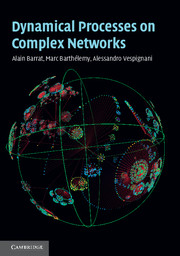Book contents
- Frontmatter
- Contents
- Preface
- Acknowledgements
- List of abbreviations
- 1 Preliminaries: networks and graphs
- 2 Networks and complexity
- 3 Network models
- 4 Introduction to dynamical processes: theory and simulation
- 5 Phase transitions on complex networks
- 6 Resilience and robustness of networks
- 7 Synchronization phenomena in networks
- 8 Walking and searching on networks
- 9 Epidemic spreading in population networks
- 10 Social networks and collective behavior
- 11 Traffic on complex networks
- 12 Networks in biology: from the cell to ecosystems
- 13 Postface: critically examining complex networks science
- Appendix 1 Random graphs
- Appendix 2 Generating functions formalism
- Appendix 3 Percolation in directed networks
- Appendix 4 Laplacian matrix of a graph
- Appendix 5 Return probability and spectral density
- References
- Index
Preface
Published online by Cambridge University Press: 05 September 2012
- Frontmatter
- Contents
- Preface
- Acknowledgements
- List of abbreviations
- 1 Preliminaries: networks and graphs
- 2 Networks and complexity
- 3 Network models
- 4 Introduction to dynamical processes: theory and simulation
- 5 Phase transitions on complex networks
- 6 Resilience and robustness of networks
- 7 Synchronization phenomena in networks
- 8 Walking and searching on networks
- 9 Epidemic spreading in population networks
- 10 Social networks and collective behavior
- 11 Traffic on complex networks
- 12 Networks in biology: from the cell to ecosystems
- 13 Postface: critically examining complex networks science
- Appendix 1 Random graphs
- Appendix 2 Generating functions formalism
- Appendix 3 Percolation in directed networks
- Appendix 4 Laplacian matrix of a graph
- Appendix 5 Return probability and spectral density
- References
- Index
Summary
In the past few years, the study of large networked systems has received a boost from the ever-increasing availability of large data sets and computer power for their storage and manipulation. In particular, mapping projects of the World Wide Web and the physical Internet offered the first chance to study the topology of large complex networks. Gradually, other maps followed describing many networks of practical interest in social science, critical infrastructures, and biology. Indeed, large complex networks arise in a vast number of natural and artificial systems. The brain consists of many interconnected neurons; ecosystems consist of species whose interdependency can be mapped into intricate food webs. Social systems may be represented by graphs describing various interactions among individuals. Large networked infrastructures such as power grids and transportation networks are critical to our modern society. Finally, the living cell is not an exception, its organization and function being the outcome of a complex web of interactions among genes, proteins, and other molecules. In the search for the underlying laws governing the dynamics and evolution of these complex systems, researchers have started the systematic analysis and characterization of their network representations. A central result of these activities is that large-scale networks are generally characterized by complex topologies and very heterogeneous structures. These features usually find their signature in connectivity patterns statistically characterized by heavy tails and large fluctuations, scale-free properties, and non-trivial correlations such as high clustering and hierarchical ordering.
- Type
- Chapter
- Information
- Dynamical Processes on Complex Networks , pp. xi - xivPublisher: Cambridge University PressPrint publication year: 2008



